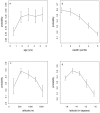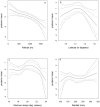Using structured additive regression models to estimate risk factors of malaria: analysis of 2010 Malawi malaria indicator survey data
- PMID: 24991915
- PMCID: PMC4084636
- DOI: 10.1371/journal.pone.0101116
Using structured additive regression models to estimate risk factors of malaria: analysis of 2010 Malawi malaria indicator survey data
Abstract
Background: After years of implementing Roll Back Malaria (RBM) interventions, the changing landscape of malaria in terms of risk factors and spatial pattern has not been fully investigated. This paper uses the 2010 malaria indicator survey data to investigate if known malaria risk factors remain relevant after many years of interventions.
Methods: We adopted a structured additive logistic regression model that allowed for spatial correlation, to more realistically estimate malaria risk factors. Our model included child and household level covariates, as well as climatic and environmental factors. Continuous variables were modelled by assuming second order random walk priors, while spatial correlation was specified as a Markov random field prior, with fixed effects assigned diffuse priors. Inference was fully Bayesian resulting in an under five malaria risk map for Malawi.
Results: Malaria risk increased with increasing age of the child. With respect to socio-economic factors, the greater the household wealth, the lower the malaria prevalence. A general decline in malaria risk was observed as altitude increased. Minimum temperatures and average total rainfall in the three months preceding the survey did not show a strong association with disease risk.
Conclusions: The structured additive regression model offered a flexible extension to standard regression models by enabling simultaneous modelling of possible nonlinear effects of continuous covariates, spatial correlation and heterogeneity, while estimating usual fixed effects of categorical and continuous observed variables. Our results confirmed that malaria epidemiology is a complex interaction of biotic and abiotic factors, both at the individual, household and community level and that risk factors are still relevant many years after extensive implementation of RBM activities.
Conflict of interest statement
Figures


 CI.
CI.
 and
and  CI respectively. The solid middle line is the posterior mean.
CI respectively. The solid middle line is the posterior mean.
Similar articles
-
Geo-additive modelling of malaria in Burundi.Malar J. 2011 Aug 11;10:234. doi: 10.1186/1475-2875-10-234. Malar J. 2011. PMID: 21835010 Free PMC article.
-
Relative importance of climatic, geographic and socio-economic determinants of malaria in Malawi.Malar J. 2013 Nov 14;12:416. doi: 10.1186/1475-2875-12-416. Malar J. 2013. PMID: 24228784 Free PMC article.
-
Childhood malaria case incidence in Malawi between 2004 and 2017: spatio-temporal modelling of climate and non-climate factors.Malar J. 2020 Jan 6;19(1):5. doi: 10.1186/s12936-019-3097-z. Malar J. 2020. PMID: 31906963 Free PMC article.
-
Geographical patterns and predictors of malaria risk in Zambia: Bayesian geostatistical modelling of the 2006 Zambia national malaria indicator survey (ZMIS).Malar J. 2010 Feb 1;9:37. doi: 10.1186/1475-2875-9-37. Malar J. 2010. PMID: 20122148 Free PMC article.
-
Spatial modelling and risk factors of malaria incidence in northern Malawi.Acta Trop. 2007 May;102(2):126-37. doi: 10.1016/j.actatropica.2007.04.012. Epub 2007 May 4. Acta Trop. 2007. PMID: 17543264
Cited by
-
Spatial disparities in impoverishing effects of out-of-pocket health payments in Malawi.Glob Health Action. 2022 Dec 31;15(1):2047465. doi: 10.1080/16549716.2022.2047465. Glob Health Action. 2022. PMID: 35322766 Free PMC article.
-
The associations between malaria, interventions, and the environment: a systematic review and meta-analysis.Malar J. 2018 Feb 7;17(1):73. doi: 10.1186/s12936-018-2220-x. Malar J. 2018. PMID: 29415721 Free PMC article.
-
Assessing the influence of socioeconomic and environmental variables on malaria risk in Nigerian children under 5 years: a GLMM approach.Malar J. 2025 Feb 21;24(1):55. doi: 10.1186/s12936-025-05289-7. Malar J. 2025. PMID: 39984916 Free PMC article.
-
Prevalence of and factors associated with malaria in children under five years of age in Malawi, using malaria indicator survey data.Heliyon. 2020 May 13;6(5):e03946. doi: 10.1016/j.heliyon.2020.e03946. eCollection 2020 May. Heliyon. 2020. PMID: 32426545 Free PMC article.
-
Improving the efficiency of reactive case detection for malaria elimination in southern Zambia: a cross-sectional study.Malar J. 2020 May 7;19(1):175. doi: 10.1186/s12936-020-03245-1. Malar J. 2020. PMID: 32381005 Free PMC article.
References
-
- Djinjalamala F (2006) Malaria. In: The Epidemiology of Malawi, University of Malawi, College of Medicine, chapter 3.
-
- National Malaria Control Programme (NMCP) and ICF International (2010) Malawi Malaria Indicator Survey (MIS). Lilongwe, Malawi & Calverton, Maryland, USA.
-
- National Malaria Control Programme (NMCP) (2011) Malaria Strategic Plan 2011–2015:Towards Universal Access. Lilongwe.
-
- Kazembe LN (2007) Spatial modelling and risk factors of malaria incidence in Northern Malawi. Acta Tropica 102: 126–137. - PubMed
Publication types
MeSH terms
LinkOut - more resources
Full Text Sources
Other Literature Sources
Medical

